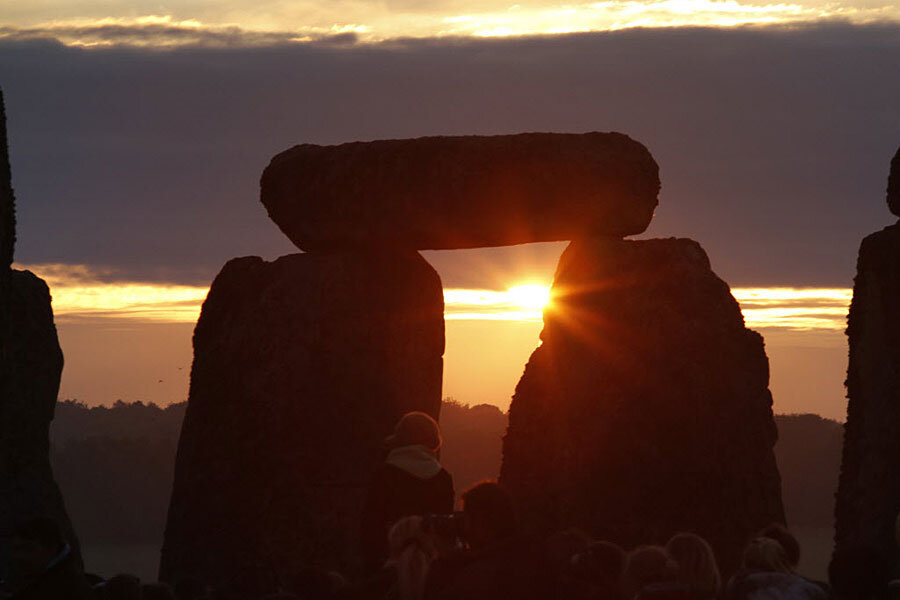When humans became farmers, how did genes change?
It's well known that humanity's transition from a hunter-gatherer lifestyle to a farming one, a period known as the Neolithic Revolution, drastically transformed diets, cultures, and natural environments. What's less known is that it also left an imprint on the human genome.
In a paper published Monday in the journal Nature, researchers describe how they looked for changes in DNA from hundreds of humans who lived in West Eurasia from 6500 to 300 BCE. They found a variety of changes that happened over those years in the human genome, ranging from metabolic adaptations to pigmentation to immunity, but mostly those relating to diet.
"You can actually watch the frequencies of different mutations changing over time," study author Iain Mathieson, a postdoctoral researcher in population genomics at Harvard University, tells The Christian Science Monitor in an interview. He describes the pattern of these mutations as "incontrovertible evidence of selection."
"This is direct observational evidence of natural selection in humans changing the human genome over a time period of a few thousand years," says Dr. Mathieson.
Becoming milk drinkers
The strongest signal of selection was lactase persistence, says Mathieson. Humans domesticated cows but couldn't initially drink their milk. "It turns out," he explains, "4,000 years ago, everyone was lactose intolerant."
But over time, the traits that made humans tolerant to cows' milk were selected over the older traits.
This didn't happen right away, however. "Actually, it kind of post-dates the domestication of cattle by many thousands of years," says Mathieson. "Cattle were domesticated at least 8,000 years ago. People were living with cattle and raising them, but apparently were not able to digest milk, at least as adults."
Lactase persistence first appears in the genome some 4,500 years ago, says Mathieson, "but even then it's very rare. It's like one person in 50."
Although the scientists found adaptations for pigmentation and other traits, "the strongest signals we find seem to be mostly related to diet," says Mathieson.
"Some of the things we find possibly are associated with an agricultural or wheat-based diet," but those are more speculative explanations, says Mathieson. Some changing traits are associated with fatty-acid metabolism and others seem to be connected to vitamin D metabolism.
"It's sort of believed that as people moved into higher latitudes and lived in darker places, they actually had to adapt very quickly to get more vitamin D," he says.
A farming migration
Farming isn't thought to have originated in Europe, so how did agricultural techniques move into the region?
This genetic study also revealed insights into the migration of early farmers.
"We knew that farming was developed in Anatolia in the near East maybe 10,000 years ago," says Mathieson. "And we knew that it moved into Europe maybe starting 8,000 years ago. It's easy to tell from the archaeology."
"But what you can't tell from the archaeology is whether that's actually people moving, or whether it's just cultural transmission, people learning to farm."
"It was a migration. And it was a massive migration," he says.
But there wasn't just one source population for Europe's farmers.
"Our model for this period in history is that there are three, possibly four, populations coming together," says Mathieson. "We have the early farmers moving from Anatolia into Europe and mixing with the European hunter-gatherers that are already there." And another group comes in later from the steppe, he says.
As those groups mixed, the genetic variation helped them adapt. The variation was shared between the different groups, as they all adapted to the European environments.
The full genomic picture
Researchers have probed the human genome for signs of natural selection before, but have mainly looked at the present-day genome rather than ancient DNA samples.
But some of these signals could be obscured, Mathieson says. Certain major population changes, like migrations and mixtures of populations or a population bottleneck, where the population suddenly shrinks, can make it difficult to discern signals of natural selection, he says. It's also difficult to pinpoint how long ago a genetic change occurred using just modern DNA.
But using ancient DNA, researchers can combine archeological findings with genetic data.
"People have looked at selection in ancient DNA before" too, says Mathieson. But they have looked specifically at traits known from present-day genetics to have been selected.
This new study examines the whole genome, tracking the frequency of mutations spotted in the ancient individuals. This allows the scientists to look for any evidence of selection rather than focusing in on a story already known or assumed.
"I don't think we found everything," Mathieson admits. "We're still limited by our sample size, so it's clear that there's a lot of stuff going on that we're not finding."
The researchers used ancient DNA from 230 West Eurasians. In addition to looking at individuals who lived before and after adaptation in Europe, they also examined DNA from those Anatolian Neolithic farmers that are credited with bringing agriculture to Europe.
"This is really the first time that we've been able to actually answer these sorts of questions," says Mathieson.
It's tricky to study genetic adaptation in people. "You can do experiments with, say, bacteria and you can watch them evolve over time, but you don’t do that with humans," Mathieson says. It would take thousands of years. "Here, what we’re doing is looking at that experiment that’s already happened."






